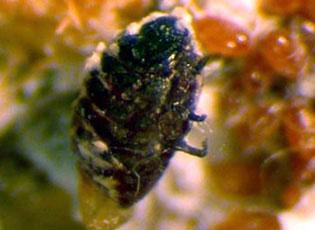Adelges tsugae (Annand) (Annand 1928)
Hemlock Woolly Adelgid (HWA)
Japan (Orwig et al. 2003)
Discovered on the West Coast in the 1920s, but it is disputed whether this was an introduced or native population; an introduced population was discovered on the East Coast in the 1950s (Havill et al. 2006; Orwig et al. 2003)
Accidental (Wallace and Hain 2006)
Destroys Eastern hemlock trees (Tsuga canadensis) (Orwig et al. 2003)

Hemlock Woolly Adelgid, Adult with wax removed
Michael Montgomery USDA, Forest Service
Find more images
Spotlights
Distribution / Maps / Survey Status
Quarantine
Videos
All Resources
Selected Resources
The section below contains highly relevant resources for this species, organized by source.
Partnership
Federal Government
International Government
State and Local Government
Academic
Annand, N.P. 1928. A contribution toward a monograph of the Adelginae (Phylloxeridae) of North America. Stanford, Calif.: Stanford University Press.
Havill, N.P., M.E. Montgomery, G. Yu, S. Shiyake, and A. Caccone. 2006. Mitochondrial DNA from hemlock woolly adelgid (Hemiptera: Adelgidae) suggests cryptic speciation and pinpoints the source of the introduction to eastern North America. Annals of the Entomological Society of America 99(2):195-203.
Orwig, D.A., D.R. Foster, and D.L. Mausel. 2003. Landscape patterns of hemlock decline in New England due to the introduced hemlock woolly adelgid. Journal of Biogeography 29(10-11):1475-1487.
Wallace, M.S., and F.P. Hain. 2000. Field surveys and evaluation of native and established predators of the hemlock woolly adelgid (Homoptera: Adelgidae) in the southeastern United States. Proceedings: Symposium on Sustainable Management of Hemlock Ecosystems in Eastern North America. GTR-NE-267: 104-109.
 An official website of the United States government.
An official website of the United States government.